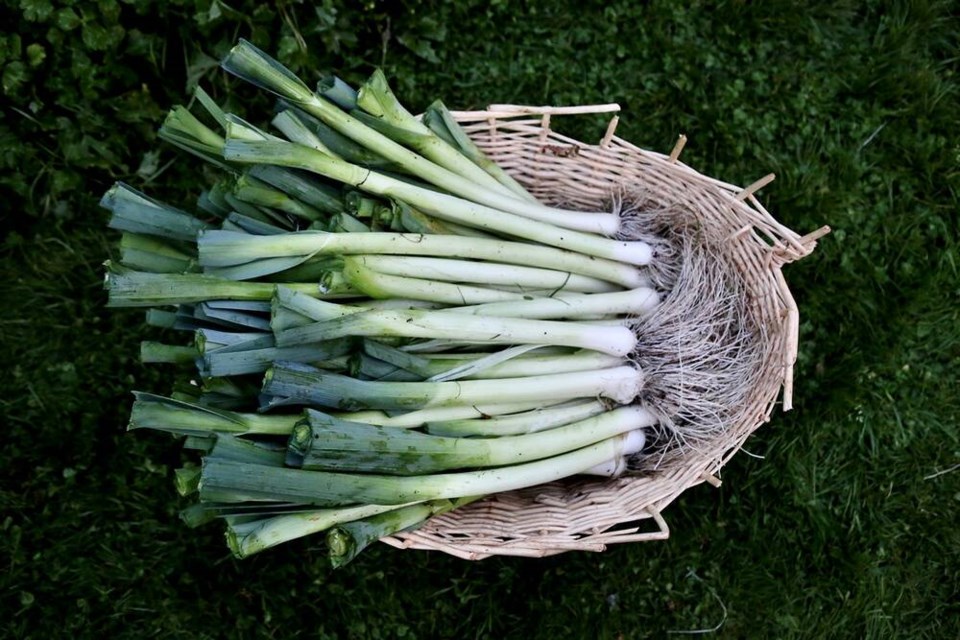Beautiful and regal, nutrient-dense leeks are one of the most underrated, under-appreciated, hardy perennial vegetables in traditional and modern landscapes.
At this time of year, leeks pile high in market stalls, inviting us to braise and roast them. Putting them in melting pots, with other good things grown below the horizon, will mute their bright summer colours.
In another life I lived among leeks, surely, as they call to me. So much that I can scarcely bring myself to unearth a single perfect stalk. I do, but would rather leave them to their own, to propagate here and there, assisted by a bird, the winds of change or passersby.
In spring and summer, leeks establish their territory slowly, growing tall and strong, providing shade for tender greens on their lees, while absorbing and reflecting solar energy from their flanks. A small, densely planted patch of leeks grown across a standard four-by-eight bed, delineates and facilitates a zone-denial nursery of sorts that I have come to depend on as we coddle rare and heritage seeds in a warming climate.
Leeks are magnificent creatures, and pound-for-pound contribute higher return on investment to our health and happiness than just about anything else in a typical food garden.
A few leeks and some humble potatoes, properly coddled long and low into some sweet butter and equal parts high fat organic milk and poultry bone broth, is one of life’s simple pleasures.
The seeds themselves are lovely at all stages of maturity – from the tiny individual pink, purple or white florets that comprise the flowering head, to the smooth and bum-like seed helmets left by the bees, to the dark fully-dried seeds. Each presentation provides culinary opportunities for experimentation and preservation.
Rarely do I pass through the food gardens and not sample or snip a small bunch of leek seeds at any phase of ripeness.
Always, the tender pastel-coloured blossoms can be used to garnish salads and soups, and also as a mild allium substitute. When dry, the tiny black seeds can be crushed or powdered to create a beautiful aromatic that is at once peppery, piquant and sweet — that “something-more-than” fabulousness that once experienced, becomes indispensable.
Recently, I experimented with dried leek bottoms and roots, leaving the cleaned and unusable butt ends to dry on a bookshelf, for use first as a feathery soup garnish, and ultimately to whizz into an oniony powder.
Welsh chef, fermenter, gardener and author Sam Cooper, offers a simple recipe for making leek capers by ruminating green-stage leek seeds (or nasturtium seeds) in cider vinegar and salt, for six months in the fridge. We do something similar with herb blossoms, for an otherworldly pizza topping.
Cooper isn’t the first Welshman to covet leeks. Leeks are the national emblem of Wales, and while the origin of the devotion has been lost to time, it is written that St. David, the Patron Saint of Wales, ordered his soldiers to wear leeks on their helmets.
Leeks are high in anti-inflammatory and antioxidant compounds like quercetin, plus they contain anti-tumor allicin, and pre-biotic fiber which supports gut health and can reduce stress hormones. Leeks contain carotenoid pigments, which have been shown to benefit brain health, and also decent amounts of essential vitamins like A, B6, C and K, as well as minerals like copper and manganese.
Wild and heirloom varieties are naturally more resilient and nutrient-dense than manipulated varieties, so opt for those if you have a choice. And always, choose organic, biodynamic or regeneratively grown leeks and other produce, if you can.
Laura Marie Neubert is a West Vancouver-based urban permaculture designer. Follow her on Instagram @upfrontandbeautiful, learn more about permaculture by visiting her Upfront & Beautiful website or email your questions to her here.
For a taste of permaculture, watch the video below:



